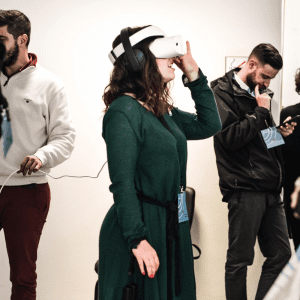The entertainment industry has experienced rapid evolution over the past few years, primarily driven by advanced technology. From how content is created to how it’s distributed and consumed, tech innovations have transformed the sector in ways unimaginable just a decade ago. Today, entertainment companies are leveraging these technologies not only to improve viewer experience but also to boost operational efficiency, broaden creative boundaries, and enhance engagement. This article will delve into the top technology trends that are reshaping the entertainment industry, highlighting their benefits, real-world examples, and impactful case studies.
1. Artificial Intelligence (AI) and Machine Learning

AI and machine learning are at the forefront of the entertainment revolution, creating more immersive and personalized content for audiences. AI can analyze vast amounts of user data to predict preferences, helping companies tailor content delivery. For instance, streaming platforms utilize AI to suggest movies, shows, or music that align with users’ tastes based on viewing history, ratings, and search patterns. This personalization has been instrumental in increasing viewer engagement and retention, as users are more likely to stay on platforms that cater directly to their interests.
Benefits:
- Personalized User Experience: AI algorithms, through deep learning, identify patterns in user behavior, providing customized recommendations that enhance viewing satisfaction.
- Efficient Production Processes: AI-powered tools can automate time-consuming tasks such as video editing, subtitle generation, and script analysis, enabling creators to focus on the creative aspects of production.
- Predictive Analytics: Machine learning models can predict which type of content is likely to succeed based on current trends, allowing studios to make informed production decisions and reduce investment risks.
Example:
Netflix’s recommendation engine is a prime example of AI in action. It not only helps users discover content they might like but also boosts Netflix’s retention rates by keeping subscribers engaged.
Case Study: Warner Bros. and Cinelytic Partnership
Warner Bros. collaborated with Cinelytic, an AI startup, to utilize AI for predicting movie performance. The AI platform uses historical data, audience sentiment analysis, and other metrics to estimate a film’s success at the box office. By leveraging AI-driven insights, Warner Bros. can optimize marketing strategies, release dates, and distribution channels, minimizing potential losses and maximizing returns.
2. Virtual Reality (VR) and Augmented Reality (AR)

Virtual reality and augmented reality have created a new realm of immersive storytelling in the entertainment world. VR offers users a simulated environment, while AR overlays digital information on the real world. Both technologies are being used not only in gaming but also in films, concerts, and live events to enhance audience experiences. In the music industry, for example, VR concerts allow fans to attend live events virtually, making it possible to engage with artists as if they were present in the same venue.
Benefits:
- Immersive Storytelling: VR and AR transform passive viewing into an interactive experience, making users feel like part of the story.
- New Revenue Models: Entertainment companies can generate additional revenue by offering exclusive VR/AR content or paid experiences, such as virtual tours, concerts, and games.
- Training and Simulation: VR is being increasingly used in film production, enabling directors and actors to visualize scenes and practice stunts in a risk-free environment.
Example:
Games like Beat Saber and Half-Life: Alyx are standout VR experiences that demonstrate how immersive gaming can be when combined with cutting-edge VR technology. AR games like Pokémon GO have also shown the potential for global mass appeal, bridging the gap between the digital and physical worlds.
Case Study: Fortnite’s AR Concerts
Epic Games has hosted several AR concerts within the Fortnite universe, featuring top artists like Travis Scott and Ariana Grande. These events were attended by millions of players worldwide, turning virtual concerts into a lucrative business model. By integrating music, visuals, and interactive elements, Fortnite has redefined how fans experience live music, making the game as much of a social platform as it is a gaming experience.
3. Blockchain and NFTs
Blockchain technology, primarily known for its role in cryptocurrency, has found new use cases in the entertainment sector. It ensures secure transactions, transparent royalty distribution, and digital ownership. NFTs (Non-Fungible Tokens), a blockchain-based form of digital assets, have become a trend in the entertainment industry, offering new ways for creators to monetize content.
Benefits:
- Secure Transactions and Ownership: Blockchain enables tamper-proof, decentralized storage of digital assets, ensuring that creators retain ownership rights and receive fair compensation for their work.
- New Monetization Avenues: NFTs allow artists, musicians, and filmmakers to create digital collectibles that fans can purchase, trade, and own as unique items.
- Transparent Revenue Distribution: Smart contracts automate royalty payments to artists and creators, ensuring timely and accurate distribution without intermediaries.
Example:
The music industry has embraced NFTs, with artists like Kings of Leon releasing their album as an NFT, giving fans unique perks such as digital album art, exclusive concert tickets, and other virtual goods.
Case Study: NBA Top Shot
The NBA, in collaboration with Dapper Labs, launched NBA Top Shot, an NFT-based platform where fans can buy, sell, and trade officially licensed video highlights. It has generated millions in sales, demonstrating how NFTs can create new fan experiences while simultaneously generating significant revenue.
4. Cloud Gaming

Cloud gaming allows users to play high-quality games on any device without the need for high-end hardware. By streaming games from remote servers, cloud gaming has removed the barrier of costly consoles and gaming PCs, making gaming more accessible.
Benefits:
- Universal Access: Players can access AAA titles on low-end devices, expanding the audience base for gaming companies.
- Lower Costs for Consumers: Since games run on cloud servers, users don’t need to invest in expensive hardware, making gaming more affordable.
- Reduced Latency and Faster Updates: Technologies like 5G have reduced latency, improving the gaming experience by making cloud gaming faster and more responsive.
Example:
Microsoft’s Xbox Cloud Gaming and NVIDIA’s GeForce Now are two of the most prominent cloud gaming platforms, offering users access to a vast library of games streamed directly from the cloud.
Case Study: NVIDIA GeForce Now
GeForce Now allows gamers to stream and play their favorite titles from the cloud. It supports games purchased on platforms like Steam and Epic Games Store, making it a versatile and convenient option. With millions of active users, GeForce Now showcases how cloud gaming can expand the market and redefine gaming experiences.
5. 5G Connectivity
5G is transforming the entertainment industry by enabling faster and more reliable internet connections. Its high speed and low latency are particularly beneficial for live streaming, VR experiences, and cloud-based content delivery. As 5G becomes more widely available, it’s expected to enhance mobile gaming, virtual concerts, and interactive live events, creating richer user experiences.
Benefits:
- Seamless Streaming: With 5G, streaming platforms can deliver high-definition content without buffering, making 4K and even 8K streaming more accessible.
- Enhanced Real-Time Interactivity: 5G enables smooth, real-time interactions in VR and AR environments, making virtual events and experiences feel more natural.
- Advanced Mobile Experiences: The technology facilitates high-quality video calls, AR applications, and real-time multiplayer games on mobile devices.
Example:
Platforms like Netflix and Amazon Prime Video have started leveraging 5G to enhance user experiences, offering faster streaming, higher quality video, and interactive content.
Case Study: BT Sport and 5G Broadcasting
BT Sport used 5G technology to broadcast live sports events in ultra-high definition, with minimal lag. By doing so, it provided a superior viewing experience, transforming how audiences consume live sports.
6. Metaverse Integration

The metaverse is an immersive virtual world that combines elements of gaming, social interaction, and digital experiences. It allows users to explore virtual spaces, interact with others, and even purchase digital goods. Major companies are investing heavily in the metaverse to create new forms of entertainment, including virtual concerts, exhibitions, and social events.
Benefits:
- Expanded Revenue Models: Virtual goods, digital real estate, and metaverse-exclusive events open up new monetization strategies.
- Interactive Social Experiences: The metaverse allows users to attend virtual gatherings, concerts, and screenings, fostering a sense of community and engagement.
- Broader Content Opportunities: Content creators can build entire virtual ecosystems within the metaverse, expanding how stories are told and consumed.
Example:
Facebook’s rebranding to Meta highlights its focus on developing the metaverse, where users can explore immersive worlds and interact with digital content in unprecedented ways.
Case Study: Decentraland’s Virtual Music Festival
Decentraland, a decentralized virtual world, hosted a virtual music festival that attracted thousands of users. Participants could watch live performances, dance with friends, and buy virtual merchandise, showcasing how the metaverse can redefine live entertainment.
7. Streaming Platforms and OTT Growth

Over-the-Top (OTT) streaming platforms have reshaped the content consumption landscape, providing users with a wide variety of on-demand content. These platforms have democratized content distribution, allowing independent creators to reach global audiences without traditional gatekeepers.
Benefits:
- Global Accessibility: OTT platforms make content available worldwide, reaching diverse audiences and driving engagement.
- Content Variety: With a focus on diverse genres, languages, and formats, OTT platforms cater to niche audiences, increasing content discovery.
- Interactive Storytelling: Advanced OTT platforms offer interactive shows and movies where viewers can make choices that influence the storyline, making content consumption more engaging.
Example:
Netflix has made headlines for its diverse content offerings, from international films to original series like Stranger Things, catering to a wide array of tastes.
Case Study: Disney+ Success
Since its launch, Disney+ has seen rapid subscriber growth, capitalizing on its vast library of beloved franchises, including Marvel, Star Wars, and Pixar. Its exclusive content strategy, featuring original series like WandaVision and The Mandalorian, has attracted millions of subscribers, demonstrating the power of content exclusivity in the competitive OTT landscape.
8. Big Data and Analytics
Big data analytics is becoming increasingly essential for entertainment companies to understand audience preferences, track content performance, and refine marketing strategies. By analyzing vast datasets from various sources, companies can make informed decisions that drive engagement and revenue.
Benefits:
- Audience Insights: Analyzing viewing habits and demographics helps creators tailor content that resonates with specific audiences.
- Marketing Optimization: Companies can optimize marketing campaigns by understanding which channels and messages are most effective.
- Content Development: Insights from data analytics can inform decisions about which projects to greenlight based on audience demand and market trends.
Example:
Streaming platforms utilize big data analytics to track viewer engagement and refine their recommendation algorithms, ensuring users are consistently presented with content that matches their interests.
Case Study: Spotify’s Discover Weekly
Spotify uses big data to create personalized playlists like Discover Weekly, which analyzes user listening habits and preferences to recommend songs. This feature has become immensely popular, boosting user engagement and retention on the platform.
Final Thought
The entertainment industry is undergoing a profound transformation driven by technological advancements that are reshaping content creation, distribution, and consumption. From AI and machine learning to the metaverse and cloud gaming, these trends offer new opportunities for creators and audiences alike. By embracing these technologies, entertainment companies can enhance user experiences, optimize production processes, and explore innovative monetization strategies, ensuring they remain competitive in an ever-evolving landscape.
As these technologies continue to develop, the potential for new, groundbreaking entertainment experiences is limitless. With each advancement, the industry moves closer to creating fully immersive, interactive, and personalized experiences that redefine how we consume and engage with entertainment.












